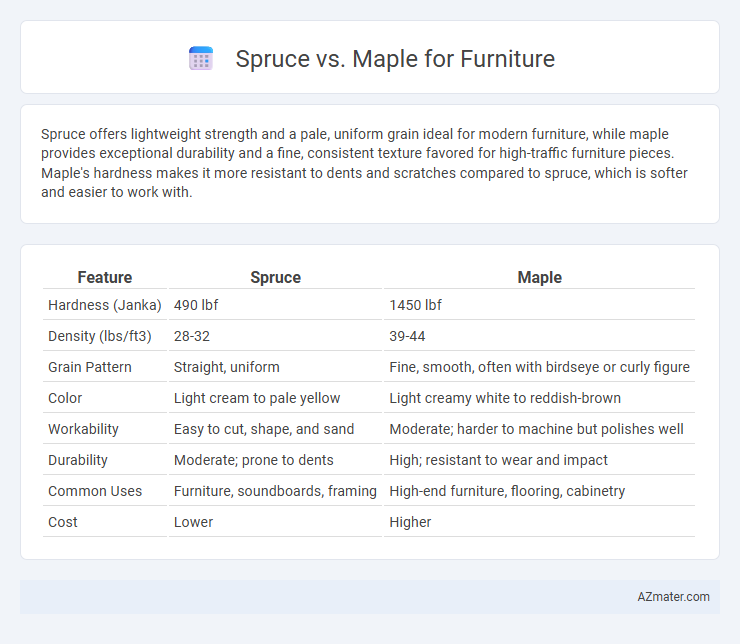Spruce offers lightweight strength and a pale, uniform grain ideal for modern furniture, while maple provides exceptional durability and a fine, consistent texture favored for high-traffic furniture pieces. Maple's hardness makes it more resistant to dents and scratches compared to spruce, which is softer and easier to work with.
Table of Comparison
| Feature | Spruce | Maple |
|---|---|---|
| Hardness (Janka) | 490 lbf | 1450 lbf |
| Density (lbs/ft3) | 28-32 | 39-44 |
| Grain Pattern | Straight, uniform | Fine, smooth, often with birdseye or curly figure |
| Color | Light cream to pale yellow | Light creamy white to reddish-brown |
| Workability | Easy to cut, shape, and sand | Moderate; harder to machine but polishes well |
| Durability | Moderate; prone to dents | High; resistant to wear and impact |
| Common Uses | Furniture, soundboards, framing | High-end furniture, flooring, cabinetry |
| Cost | Lower | Higher |
Introduction: Spruce vs Maple for Furniture
Spruce and maple are popular wood choices in furniture making, each offering distinct characteristics. Spruce features a light color with a straight grain, known for its lightweight and softness, making it easier to work with but less durable. Maple, on the other hand, is a hard, dense wood with a fine, uniform texture that provides excellent strength and resistance to wear, ideal for high-quality, durable furniture pieces.
Botanical Overview: Spruce and Maple Wood
Spruce wood, derived from coniferous trees in the genus Picea, is characterized by its lightweight, straight grain, and pale color, making it suitable for furniture requiring a softwood with good workability. Maple wood, sourced from deciduous trees in the genus Acer, features a dense, hard texture with a fine, uniform grain and creamy white to light reddish hues, favored for durable furniture with high resistance to wear. Both species offer distinct botanical traits influencing their mechanical properties and aesthetic appeal, affecting furniture design and longevity.
Appearance and Grain Patterns
Spruce furniture typically features a light, pale color with a fine, straight grain that provides a simple, clean look suitable for minimalist or rustic designs. Maple offers a slightly warmer tone with a denser grain pattern that ranges from straight to curly or wavy, adding visual interest and elegance to furniture pieces. The choice between spruce and maple largely depends on whether the desired style favors subtle uniformity or rich, varied textures in wood grain.
Strength and Durability Comparison
Maple is significantly stronger and more durable than spruce, making it a preferred choice for high-traffic furniture and hardwood flooring. Spruce is softer with a lower Janka hardness rating, which limits its resistance to dents and wear over time. For furniture that requires long-lasting structural integrity, maple offers superior stability and longevity compared to spruce.
Workability for Furniture Makers
Spruce offers excellent workability due to its lightweight nature and straight grain, making it easy to shape and sand for intricate furniture designs. Maple, especially hard maple, is denser and tougher, providing superior durability but requiring more effort and sharper tools for cutting and finishing. Furniture makers often choose spruce for projects prioritizing ease of use and maple for pieces demanding strength and long-lasting wear.
Weight and Density Differences
Spruce is significantly lighter than maple, with a density averaging around 400 kg/m3 compared to maple's 700 kg/m3, making spruce ideal for lightweight furniture. Maple's higher density contributes to its superior strength and durability, suitable for heavy-use pieces. Choosing between spruce and maple depends on whether weight or sturdiness is the priority in furniture design.
Cost and Availability
Spruce furniture typically offers a lower cost compared to maple due to its faster growth rate and wider availability in North American regions. Maple, known for its durability and fine grain, commands higher prices and can be less abundant, especially in large, clear cuts required for furniture-making. Availability for spruce is generally consistent, making it a budget-friendly choice for mass production, whereas maple's supply fluctuates with demand in the hardwood market.
Environmental Impact and Sustainability
Spruce furniture, sourced from fast-growing coniferous trees, offers a lower environmental impact due to its rapid regrowth and efficient carbon sequestration compared to slower-growing maple. Maple, while durable and dense, tends to require more energy-intensive processing and longer harvest cycles, potentially increasing its ecological footprint. Choosing sustainably certified spruce or maple ensures responsible forest management and supports long-term biodiversity conservation.
Best Uses: Spruce vs Maple in Furniture Design
Spruce offers lightweight properties and a straight grain, making it ideal for furniture pieces that require ease of handling and a rustic or Scandinavian aesthetic. Maple, known for its durability and fine, smooth grain, excels in high-traffic furniture such as dining tables and cabinets where strength and a polished finish are essential. Both woods provide distinct advantages: spruce is favored for decorative or temporary furniture, while maple is preferred for long-lasting, heavy-use designs.
Final Verdict: Choosing the Right Wood for Your Furniture
Spruce offers a lightweight and cost-effective option with a pale, uniform grain ideal for rustic or modern furniture designs, while maple provides superior hardness, durability, and a fine, intricate grain pattern perfect for high-traffic or heirloom pieces. The final choice depends on the intended use; maple is best suited for furniture requiring long-lasting strength and resistance to wear, whereas spruce is optimal for budget-friendly, decorative, or less frequently used items. Consider factors like hardness rating, grain aesthetics, weight, and maintenance to determine the right wood for your specific furniture needs.

Infographic: Spruce vs Maple for Furniture
 azmater.com
azmater.com